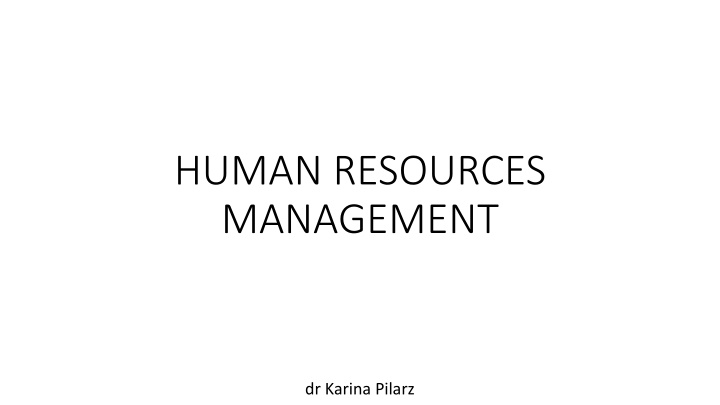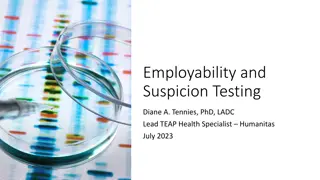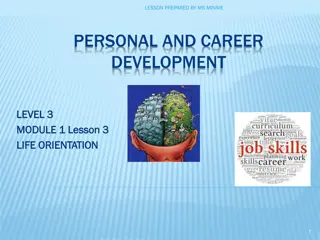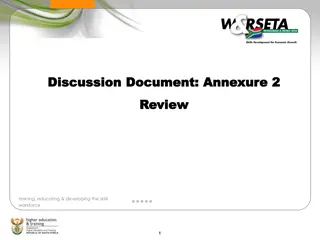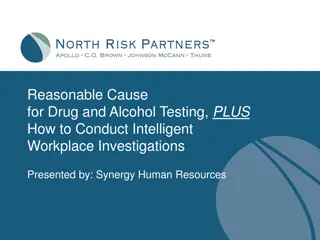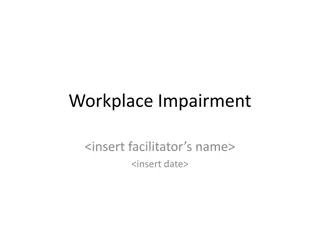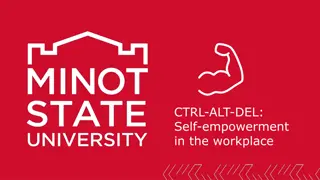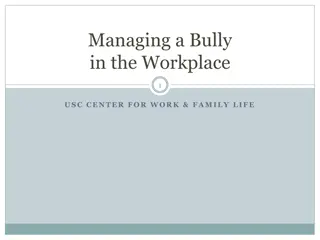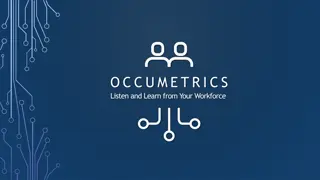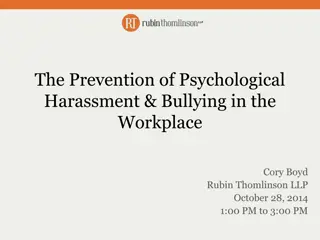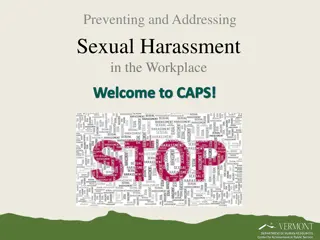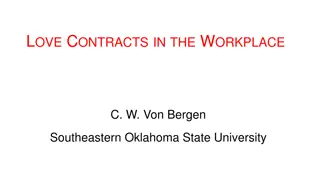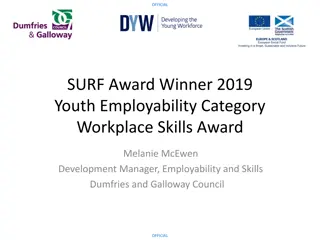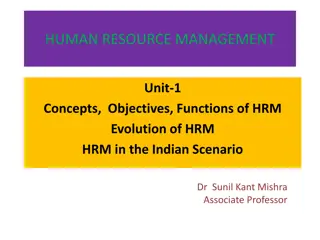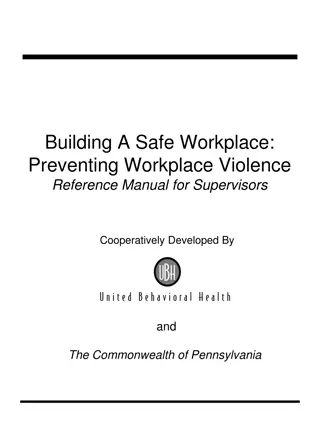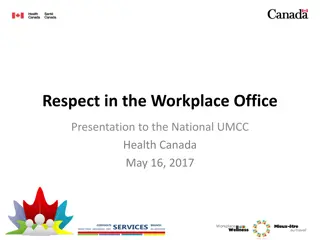Workplace Skills Assessment and Its Importance in Human Resources
Workplace skills assessment is a valuable method to evaluate an individual's performance and potential on the job. It helps in identifying training needs, determining if employees are well-suited for their roles, and uncovering skills that can be leveraged for future opportunities. A good assessor plays a crucial role in this process and should be knowledgeable, experienced, and able to assess from a broader perspective. Employers can use skills assessments for hiring purposes by benchmarking candidates against the ideal profile for a position, gaining insight into candidates' skills, emotional intelligence, temperament, and motivation.
Uploaded on Sep 13, 2024 | 1 Views
Download Presentation

Please find below an Image/Link to download the presentation.
The content on the website is provided AS IS for your information and personal use only. It may not be sold, licensed, or shared on other websites without obtaining consent from the author.If you encounter any issues during the download, it is possible that the publisher has removed the file from their server.
You are allowed to download the files provided on this website for personal or commercial use, subject to the condition that they are used lawfully. All files are the property of their respective owners.
The content on the website is provided AS IS for your information and personal use only. It may not be sold, licensed, or shared on other websites without obtaining consent from the author.
E N D
Presentation Transcript
HUMAN RESOURCES MANAGEMENT dr Karina Pilarz
WHAT IS A WORKPLACE SKILLS ASSESSMENT? Assessing an individual s skills while they are on the job is a valuable way of determining whether they are performing to the required standard, whether further training may be needed, or whether they have skills that can be utilised in other areas (such as in future team leadership or managerial capacity).
A workplace skills assessment involves observing a candidate as they perform their daily tasks, often over a period of time, and using a variety of methods to gain an all-round picture of that person s current abilities and future potential.
To zdjcie, autor: Nieznany autor, licencja: CC BY-SA From an organisation s point of view, workplace assessment can determine: whether the right people are in the right jobs, whether further training is required, which employees have the potential to benefit the organisation in the long term.
Good assessor Workplace assessment is only as good as those who are doing the assessing. An assessor needs to be at least as qualified as the person they re observing and should preferably be someone who is able to read between the lines and see things from a big picture point of view. A good assessor should also: hold formal recognition of competence as an assessor; have extensive knowledge of the industry in which the assessment is being conducted, including best practice standards; have a relevant work history in the same or related industries.
How How can workplace? workplace? can skills skills assessments assessments be be used used in in the the 1. Hiring & Benchmarking Assessments are a valuable tool for employers to get instant insight into their potential employees. This process often involves benchmarking, the process of creating the profile of the ideal candidate for a position and then measuring candidates own assessment results against that profile.
This process helps employers understand the skills, emotional and social intelligence, temperament, and motivation of their job candidates. For example, if a role will require lots of research, fact- checking, and slow but steady progress, a person who prefers a faster pace and more direct behavior might be unhappy. Benchmarking helps prevent bad hires, and it s achieved assessments. through job candidate
2. Career Development Employment engagement is crucial for organizational success. If the team isn t invested in their work and achieving the best possible results, productivity and company culture will suffer. When employees get a tangible investment in their wellbeing and professional development, they ll return and surpass that investment with their work.
3. Skills Gap Management The world of work is changing quickly, and sometimes that can mean that a position evolves beyond the person currently filling it. Skills assessments are the key to retaining current while figuring out how to develop them for success. Job benchmarks can be used again here to get a sense of the ideal candidate. Measure the current employee s results against this benchmark and you ll find out exactly where to start developing their talents. The skill assessment process is often associated with hiring and firing, so employees need to know that it s for their benefit and development upfront.
Benefits increased employee satisfaction, resulting in less absenteeism and higher staff retention rates; increased employee participation leading to higher productivity; cost savings by being able to provide targeted training that aligns with company objectives, without leaving the workplaces; by being a valuable resource of potential candidates for dynamic succession planning
What challenges can skills assessments help organizations overcome? 1. Improve Employee Retention Keep your current team happy with the improved communication and understanding that comes from assessments. 2. Increase Hiring Accuracy Find the perfect fit for every position with the right employee as determined by the data that comes from benchmarking. 3. Promote Productivity Assessments give your team a shared language and understanding of each other s behavior, which cuts down on misunderstandings and conflict. 4. Advance Workplace Engagement When you invest in your organization, they will invest in their work. When employees are truly understood in their workplace, engagement increases. 5. Reduce Destructive Stress Stress affects physical and mental health as well as engagement and productivity. By increasing understanding of the self and of others, conflicts can be prevented before they start.
OBSERVATION SIMULATION ASSESSMENT METHODS QUESTIONING TESTING
OBSERVATION The assessor literally looks over the employee s shoulder, observing how they perform their daily tasks. It is one of the most direct means of determining competency, because unlike a simulation, actual workplace resources and facilities are being used. It is also one of the most cost-effective methods, as workflow is not being interrupted. One possible disadvantage of this method is the fact that the employee is aware they are being observed. This may intimidate them and detract them from their performance, or it may cause them to behave in the way they think the assessor would want them to, instead of how they would normally do things. One way to overcome this would be to perform the observations over time, so that the employee becomes used to observation and begins to behave naturally again. Another method would be to inform them of the reason behind the assessment and allay any fears they may have that it is in any way personal or negative in nature. To zdj cie, autor: Nieznany autor, licencja: CC BY-NC-ND
SIMULATION This is where a workplace is simulated in a classroom or workshop environment. It can involve hands-on tasks if the employees are being assessed for their technical skills, or role playing if assessing those from a corporate environment. Simulation is particularly useful for testing behaviour in emergency situations that don t normally happen in the employee s day-to-day environment. The main disadvantage of this method of assessment is that everyone is aware they are being assessed, which can affect their behaviour. Because it is simulated, it can also never give as true a picture as the real thing.
QUESTIONING This can take the form of an interview or a series of casual conversations, and because it is oral, it does not disadvantage employees with reading or writing abilities. Here, the assessor asks in-depth questions about the employee s perceptions of their role, their goals for the future, and things they would improve in the workplace. It can be a useful means of not only assessing the employee but also providing valuable information for the organisation that may not otherwise have been available. One drawback is that the success of this form of assessment is entirely dependent on the style and communication skills of the assessor. If there is no rapport between the assessor and the subject, useful information may be thin on the ground. One way to overcome this would be to conduct such sessions in a group environment rather than one-on-one, so that the employee has the support of their peers. To zdj cie, autor: Nieznany autor, licencja: CC BY-NC-ND
TESTING This is a method that most employees would be familiar with, and it can provide extensive information on their knowledge and experience. The assessor sets a test, ideally involving a combination of theory and practical tasks, and marks the employee(s) according to a predetermined yardstick. The main disadvantage of this method is the same as in any exam environment: the fact that some people do better than others under this kind of pressure. It also may not give a true indication of an employee s abilities due to its limited nature. While these methods of assessment all have validity, the most effective kind of workplace skills assessment is a blended learning solution. This is one that combines elements from a number of different assessment methods to create a more complete picture of an employee s overall skill set. To zdj cie, autor: Nieznany autor, licencja: CC BY
Why do companies use skills assessment tests? To better understand and develop employees in a way that benefits their long- term values and goals To identify areas in which the company is successful or struggling, therefore providing information on areas or departments that may require more training To provide a comparison between the organization's talent and abilities against the geographical or industry standards
Types of skills assessment tests Hard skills assessment Work sample test Cognitive ability test Personality test The interview Combination approach
Hard skills assessment These types of tests are used to measure a person's skills in a specific area, such as software development, math or typing. The results of hard skills testing provide valuable information about the proficiency of candidates when completing frequently performed work activities.
Work sample test Sometimes referred to as "realistic job previews," work sample tests are designed to resemble certain tasks that employees are expected to perform in their position, such as situational judgment tests, case study presentations and technical coding tests. The results of these assessments are usually indicative of a candidate's actual job performance because of how closely they mimic the actual duties related to the position.
Cognitive ability test Unlike work sample tests that measure how applicants would perform in expected, everyday situations, cognitive ability tests assess how candidates would perform in more unexpected scenarios. They do this by evaluating a person's ability to think abstractly when using numerical and verbal reasoning skills. Nowadays, game-based assessments are commonly used to measure cognitive ability. The format is more approachable for the candidate and the process is typically much faster than the more traditional cognitive skills tests.
Personality test Personality tests measure specific aspects of a candidate's personality, which can be extremely beneficial when hiring someone for a role that requires a particular demeanor. For example, a highly extroverted person would be a great fit for a role that has a lot of customer interaction, such as sales.
The interview When properly executed, interviews can be a great way to assess the hard and soft skills that a candidate possesses. Interviews are flexible and often used independently or as a supplement for other assessment types.
Combination approach Many organizations choose to combine several assessment tests rather than utilize just one. This provides more comprehensive results that will eliminate the weaknesses of using only one assessment. However, this approach does take more of the candidate's time.
